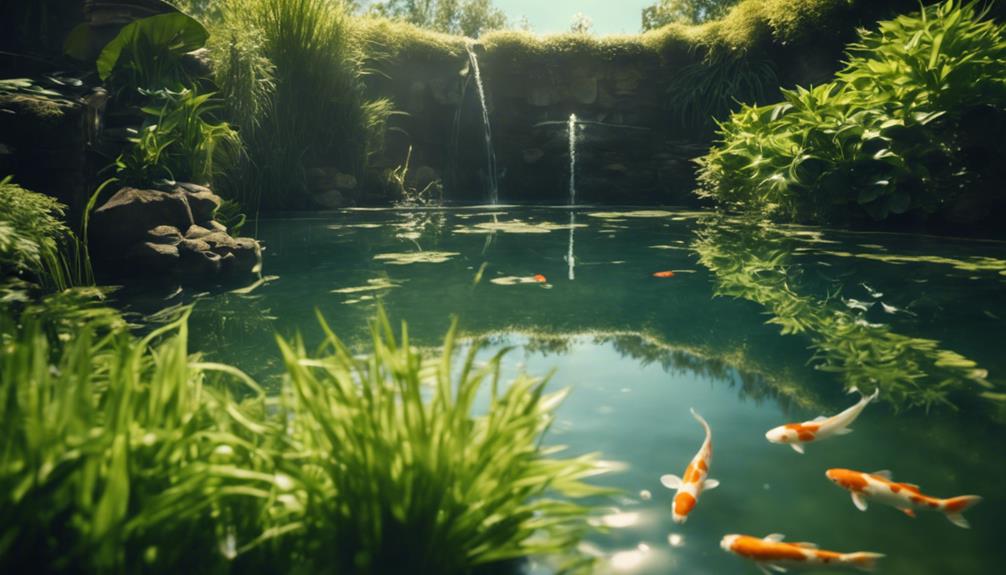To optimize your pond's water quality for healthy koi, you'll need to monitor and maintain essential parameters like pH levels, dissolved oxygen, and ammonia levels. Aim for a pH between 6.5 and 8.5, dissolved oxygen above 3-4 ppm, and zero ammonia. Regular water testing helps track changes in water quality, identifying potential problems before they become serious issues. Effective filtration and aeration systems, along with beneficial bacteria and microbes, also play a key role in maintaining a healthy environment. By keeping these factors in check, you'll be well on your way to creating a thriving ecosystem for your koi – and there's more to discover about how to fine-tune your pond's water quality.
Table of Contents
Key Takeaways
- Regularly test and monitor pH levels, dissolved oxygen, and ammonia levels to ensure they fall within recommended ranges for healthy koi.
- Implement a well-designed filtration system that processes at least 50% of the pond's water volume per hour to improve water quality.
- Perform regular water exchanges (10% weekly) to remove built-up toxins and prevent algae blooms, and maintain stable water temperatures.
- Foster a balance of beneficial bacteria and microbes by providing adequate aeration and circulation, and avoiding overfeeding.
- Record and analyze test results to identify potential issues before they become major problems and take prompt corrective action.
Understanding Water Quality Parameters
When it comes to maintaining a healthy koi pond, getting a handle on water quality parameters is essential, as even slight deviations from ideal levels can have devastating consequences for your fish.
You need to keep a close eye on pH levels, which should fall between 7 and 8, as fluctuations outside of this range can cause stress and disease in your koi.
Dissolved oxygen levels are also vital, and you should aim for a minimum of 3-4 parts per million (ppm) to safeguard healthy fish.
Don't forget to test for ammonia, which is toxic to koi even in low concentrations, so you want to maintain a level of 0 ppm.
Regular water testing will help you track changes in water quality over time, allowing you to identify potential problems before they become serious issues.
Maintaining Stable Water Conditions
As you work to maintain stable water conditions in your pond, you'll need to focus on monitoring pH levels and controlling water temperature.
You should regularly test your pond's pH levels to maintain them between 7 and 8, which is essential for healthy koi.
Ph Level Monitoring
You must regularly monitor pH levels to maintain your pond's water quality remains stable, as even slight fluctuations can have devastating effects on aquatic life.
Koi, being sensitive to pH changes, can experience stress, illness, or even death if the water's pH level strays too far from the ideal range of 6.5 to 8.5.
To guarantee your koi thrive, making regular pH tests a priority is crucial, preferably during the morning when pH levels tend to be at their most stable. You can use pH test kits or pH meters to get an accurate reading.
If you notice any fluctuations, take corrective action immediately. For instance, if the pH level is too high, you can add pH-lowering agents like peat moss or driftwood to bring it back down.
Conversely, if the pH level is too low, you can add pH-raising agents like soda ash or limestone.
Water Temperature Control
Maintaining stable water temperature is equally essential to pH level monitoring, since koi are sensitive to temperature fluctuations that can disrupt their metabolic balance and immune function.
As a responsible pond owner, you should aim to keep the water temperature between 35°F and 85°F (2°C and 30°C), with an ideal range of 65°F to 75°F (18°C to 24°C) for perfect koi health.
Sudden changes can cause stress and disease, so it's vital to manage temperature fluctuations using pond heaters, chillers, or shade-providing plants, depending on the climate and seasonal changes.
Regularly monitoring water temperature helps detect potential issues, such as equipment failure or extreme weather conditions, allowing for prompt corrective actions.
Remember, avoiding water temperature extremes, such as those above 90°F (32°C) or below 40°F (4°C), is essential to prevent koi stress, disease, and even death.
Effective Filtration and Aeration

By incorporating a well-designed filtration system that can process at least 50% of the pond's water volume per hour, you can significantly improve water quality and create a healthier environment for your koi. This is especially vital since koi require a minimum of 3-4 parts per million (ppm) of dissolved oxygen to thrive.
To further enhance water quality, consider implementing an aeration system. This will increase dissolved oxygen levels, allowing for a healthier and more thriving koi population.
Aeration systems increase dissolved oxygen levels, essential for koi health. Agitation of water through aeration increases the surface area and diffusion rate, allowing for more efficient oxygen exchange and removal of unwanted gases like hydrogen sulfide.
Regular cleaning and maintenance of filters and aeration systems are vital to prevent clogging and promote peak performance.
Installing a bottom drain and settling tank can improve filtration efficiency by removing heavy debris and sediment from the pond floor.
A well-maintained filtration and aeration system will promote better water circulation, reducing the risk of rapid water quality decline.
Beneficial Bacteria and Microbes
As you work to optimize your pond's water quality, you'll want to focus on cultivating beneficial bacteria and microbes.
These microorganisms play a vital role in breaking down organic matter, reducing toxins, and maintaining a healthy ecosystem.
Balance Bacteria Levels
You need to strike a delicate balance between beneficial bacteria and microbes in your pond's ecosystem to prevent the proliferation of harmful organisms that can degrade water quality.
When bacteria levels are out of balance, it can lead to water quality issues that can harm your koi. Beneficial bacteria play a vital role in breaking down organic matter, reducing ammonia, and maintaining a healthy nitrogen cycle.
To achieve the right balance, consider the following:
Regularly test your pond's water for ammonia, nitrite, and nitrate levels to verify they're within safe ranges.
Maintain adequate aeration and circulation to support beneficial bacteria growth.
Avoid overfeeding your koi, as excess food can lead to an overgrowth of harmful bacteria.
Add beneficial bacteria supplements or introduce natural sources like compost or manure to boost beneficial bacteria populations.
Monitor your pond's pH levels, as beneficial bacteria thrive in a slightly acidic to neutral environment (pH 6.5-7.5).
Microbe-Rich Pond Environment
Creating a microbe-rich pond environment is vital for maintaining a healthy ecosystem, as it allows beneficial bacteria and microbes to thrive and break down organic matter, reduce ammonia and nitrite levels, and promote a balanced nitrogen cycle.
As a pond owner, you can achieve this by introducing beneficial bacteria supplements, such as Microbe-Lift, which contain strains of bacteria specifically designed to thrive in aquatic environments and promote water quality.
You can also use natural methods, like adding plants, rocks, and driftwood to the pond, providing a habitat for beneficial bacteria to colonize and multiply.
A healthy balance of beneficial microbes can help reduce the risk of disease and stress in koi, by competing with pathogenic bacteria for space and resources, and producing compounds with antimicrobial properties.
Regularly monitoring water quality parameters, such as ammonia, nitrite, and nitrate levels, confirms the pond environment is conducive to the growth and proliferation of beneficial microbes.
Monitoring and Testing Water Quality

Regular monitoring and testing of pond water quality are essential steps in evaluating the health and balance of the aquatic ecosystem, allowing you to identify potential issues before they become major problems.
By testing your pond water regularly, you can assess the quality and health of the water, identifying imbalances and potential issues before they escalate.
pH levels: 7-8
Ammonia and nitrite levels: 0 ppm
Nitrate levels: less than 60 ppm
Dissolved oxygen levels: at least 3-4 ppm for healthy fish
Record and analyze test results, comparing them to recommended ranges, and take actions based on results, such as adjusting pH, managing nutrients, aerating, and implementing management practices.
Preventing Algae Growth and Disease
By maintaining a balanced ecosystem and addressing potential water quality issues identified through regular monitoring and testing, you can prevent algae growth and disease from taking hold in your pond.
This balanced ecosystem includes a sufficient number of beneficial bacteria, plants, and aeration, which help remove excess nutrients and reduce algae-forming conditions.
Regular water testing and monitoring of parameters such as pH, ammonia, nitrite, and nitrate levels can help identify potential algae growth triggers and allow for prompt corrective action to be taken.
Implementing a regular water exchange schedule, such as 10% every week, can help remove built-up toxins and prevent the formation of algae blooms.
Additionally, ensuring adequate filtration, such as using a high-quality filter system, can help remove waste and excess nutrients that can contribute to algae growth.
Frequently Asked Questions
How Do I Improve the Water Quality for My Koi Pond?
To improve your pond's water quality, you'll want to prioritize regular testing, ensuring ideal pH, ammonia, and nitrate levels. Boost water circulation with a high-performance pond aeration system, promoting healthy oxygen exchange and circulation.
What Is the Best Water Quality for Koi Fish?
You'll want to maintain ideal water quality for your koi by ensuring pH levels range from 7-8, completing the nitrogen cycle, and achieving 3-4 ppm oxygen saturation to create a thriving environment.
How to Prepare Pond Water for Koi?
As you venture on this watery journey, prepare your pond water for koi by conducting regular water testing, allowing for a natural pond cycling process, and making adjustments during seasonal shifts to create a thriving habitat.
How Do I Make My Koi Pond Water Crystal Clear?
To achieve crystal-clear water, you'll need to prioritize pond maintenance, focusing on algae control through regular water changes, efficient filtration, and aquatic plants, which will improve water clarity and create a thriving environment for your koi.
Conclusion
As you tend to your pond, remember that maintaining ideal water quality is like conducting a symphony – every element must harmonize to create a thriving environment for your koi.
Just as a discordant note can disrupt the entire melody, a single water quality parameter out of balance can have devastating consequences.
By following these guidelines, you'll be the maestro of your pond, orchestrating a healthy and vibrant ecosystem where your koi can flourish.

